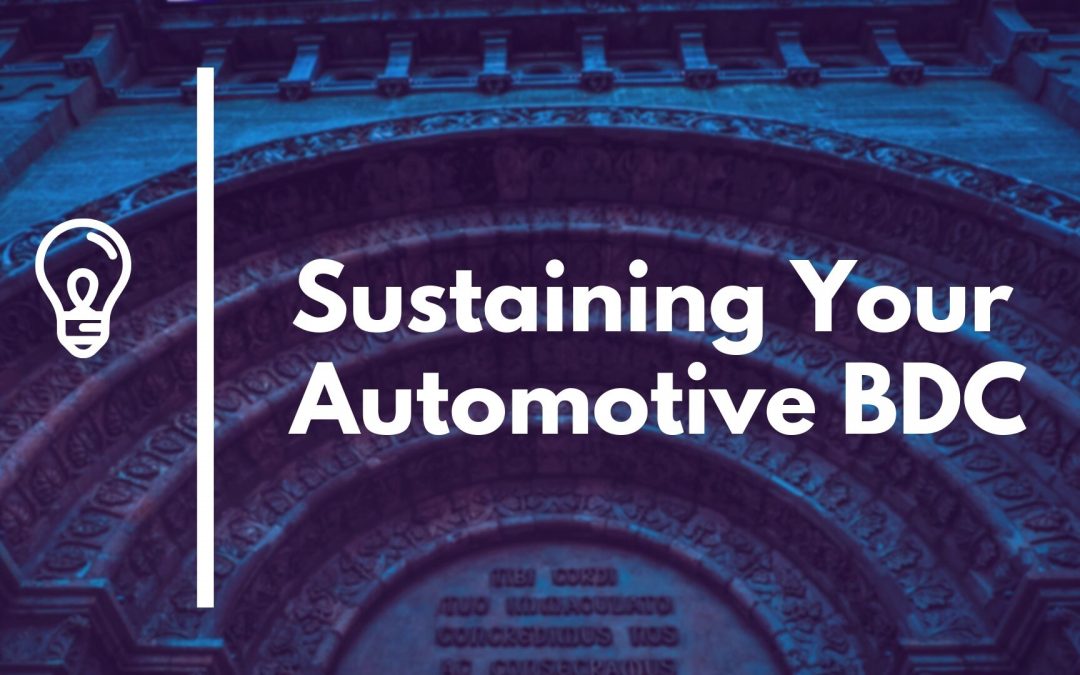
by Andrei Smith | Sep 21, 2019 | BDC Training, Mastering Sales
Update, 6/18/20: There has been talking lately online about having pay plans tier off of percent closing. I think that this is a great way to avoid the problem of having BDC representative set appointments that have a low closing rate. The idea would be that in order to get the full commission per appointment the overall closing rate needs to hit a set figure.
For example, if a BDC representative’s appointment closing rate dipped below 20%, their per appointment commission would drop by 20%. If it dipped below 10%, then it would drop by an additional 20%.
Note that this type of structure does require active managing. If your entire store’s appointment closing rate is 15%, then the example above would only punish good representatives!
You can not afford to build an Automotive BDC that is unsustainable. The cost of hiring, training, and onboarding new representatives is incredibly high and needs to be avoided at all cost. You want your representatives to stay at your dealership for as long as possible. It is better for the culture and the bottom line.
It is critical for the success of your dealership that you implement a sustainable BDC pay plan.
If your BDC pay plan is unsustainable, you will have to shut it down during the slow parts of the automotive sales cycle.
Your BDC pay plan needs to scale with the volume of sales that your dealership generates, and it needs to be able to pivot during a downturn.
Today I am going to review three ways that you can make your BDC more sustainable. This article is a follow up to my thoughts on the recent article “4 Ways to Stand Out in a Cooling Market.”
Rely Heavily on Commission for the BDC Pay Plan
Having your dealership’s BDC pay plan rely heavily on commission allows your dealership to avoid manual pay cuts during downturns.
Here is an example pay plan from my dealership:
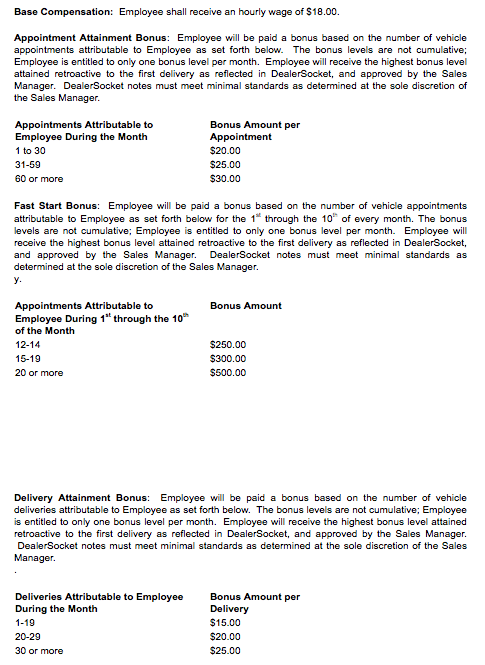
This pay plan is heavily weighted towards earning a commission since the vast majority of the compensation is locked in the BDC representative scheduling appointments that show and buy.
Even this pay plan would have benefited, in retrospect, with a slightly lower base hourly rate and marginally higher commissions. The less weighted towards hourly rate your BDC representatives are, the less financial burden they cause during the downturns.
Cycle the Lists
I recommend in the Automotive BDC Manifesto having your BDC representatives call the store’s fresh up customers (Chapter 3: Working the Floor Traffic). This way your dealership is less likely to lose deals when floor salespeople take their days off or forget to call their weekend drop-ins.
That said, there is an under-discussed danger involved with this plan: your salespeople can grow complacent, and begin to rely too much on the BDC.
If this happens, the net output of your dealership will decrease or stay the same, regardless of the efficiency of the BDC. In the worst case, the harder the BDC works, the less your floor salespeople will work, as they will recognize the “free labor” that the BDC offers.
How can you avoid this?
One way is to cycle the salespeople that your BDC representatives follow-up for. This will allow your sales managers to monitor the follow-up of your floor salespeople since the truth will be revealed when the BDC is not following up for them.
In a way, this is a way that you can keep your BDC pay plan sustainable since your BDC won’t make your salespeople lazy.
Search for New Opportunities
The BDC has a base pay, which differentiates them from most salespeople. Because of this base pay, they can be asked to follow-up with experimental customer groups that your sales team might not have had success with in the past.
An example experimental group may be service not sold customers. Many CRMs will be able to cross-reference your service appointment log with your sales CRM to provide you a list of customers that service at your dealership but did not initially buy from your store.
These are great potential future customers, but since this lead source will have a lower closing ratio, it can be challenging to motivate floor salespeople to pursue it. Since your BDC has a base pay, instructing them to follow up with these customers is a smaller pill to swallow.
Every market is different. The opportunity to explore new customer lists is a great part of having a BDC.
Bill the Deals
Your BDC’s work setting appointments should be thought of as an acquisition cost of selling cars. Most dealers have a “pack” that they bill every car deal that is meant to pay for the fixed costs of selling the vehicle (such as detail, marketing, and admin work).
To properly account for the cost of your BDC, it may be wise to bill your deals the average commission of your BDC representative (refer to your BDC pay plan for an idea of the average commissions).
The one thing you want to avoid is a confusion of incentives. Your goal is to sell cars, and for your team to successfully work together to accomplish that, you all need to appreciate each other. If you bill the deal too much, you can run the risk of salespeople resenting the BDC affecting their commissions.
That said, it is a worthwhile accounting strategy to consider. Protecting your BDC and keeping it financially sustainable is critical.
Your Thoughts?
What are some ways that you can make sure that your BDC doesn’t get cut during the next economic downturn? How can you build a sustainable BDC pay plan?

by Andrei Smith | Aug 1, 2019 | Mastering Sales
Part of being a successful car salesman (or saleswoman) is keeping your eye on your earnings. Your income is the most straightforward single metric to use (as a salesperson) to measure your worth to your company.
I’ve written this article to guide you the simple steps I followed to make my first million selling cars (in six years).
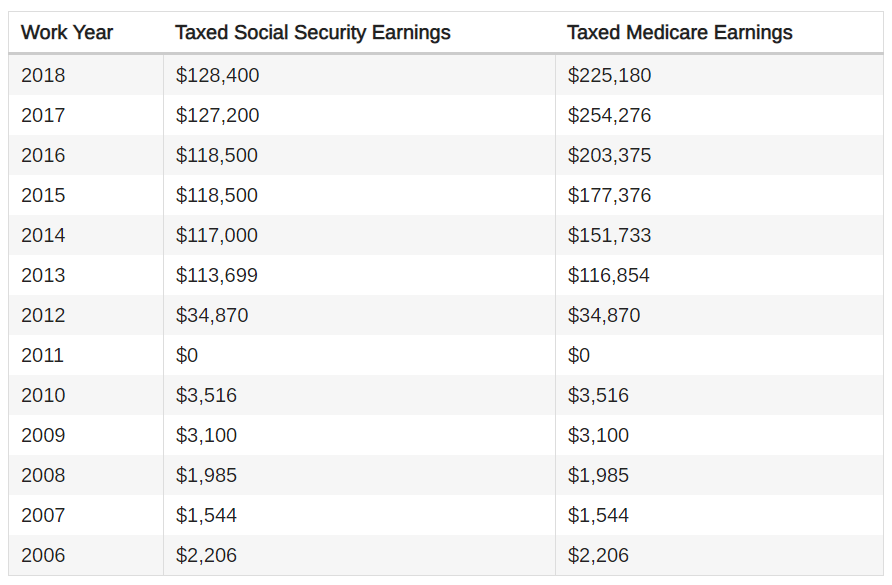
The Right Column is my Gross Income (I started selling cars mid 2012)
Note: This article is for current and future car salespeople and my BDC reps that are considering switching over to floor and internet sales.
Now, make sure you don’t misunderstand my perspective. I don’t think that your earnings are the end-all of who you are as a human being. Instead, I propose that your income most easily quantifies your worth to your company.
Just like a high demand car commands a high value, a high-quality salesperson should demand a high income.
Sales is a brilliant career because your income (assuming it is commission) correlates directly to the profit your business produces.
Consider the alternative. If you had a career in human resources, how do you quantify your value? Your effect on the companies bottom line will have to be extrapolated from abstract numbers such as employee turn over and payroll accuracy.
In sales, if the store makes money, you should too.
I believe in the car sales career because it has worked for my friends and me.
Becoming a Successful Car Salesman
The beauty of the car sales career is that you can learn on the job. Every skill that you need to be successful is taught by the repetition of situations that come up at the dealership.
The car sales career is unique because of it’s short sales cycle. As a salesperson, you can have five attempts to make a sale on one Saturday afternoon.
Compare that to the other sales jobs with similar incomes. In technology sales, your product is often a subscription that needs to be approved by a VP or C-level executive. You pitch your product to whoever you can, and you slowly work your way up the food chain at the company. A sale can take 6-12 months!
What if you made a mistake early in the process (product knowledge misunderstanding, overpromising, annoying the wrong person). You might not realize that the whole deal was going to fall apart for months.
With that type of job, your personal growth can take time. Your opportunities to iterate your process and improve only appear when you make mistakes.
Creating Opportunity
So we come to the beauty of the car sales career.
This is a career where, if you are paying attention, you can make mistakes and improve every day. Your sales cycle is measured in hours, not weeks or months.
So how do you create the opportunity for yourself?
You take more chances.
That means you need to talk to more “ups.”
You should be fighting for every opportunity that comes your way. Not because every customer is worth talking to, but because every customer is an opportunity for you to learn something.
The Math of Success (Customers/Day)
Let’s say you want to make a million dollars, like I did, in your first six years.
What does that take?
There is some simple “work-backward” math that we can do together.
For my example, we will assume that you make $500 per car sale if you average out all of your bonus and commissions.
Then, we will assume you close 20% of the customers that you talk to.
Let’s work backward.
One million dollars, divided by six years, is $166,660 per year.
$166,666 per year is $13,888 per month.
$13,888 per month, divided by $500 per car, is 27 cars sold per month.
So you need to sell 27 cars per month, for six years, to make a million dollars (before tax).
We said earlier that you close 20% of the customers that you talk to, which is one in five.
If you sell one in five customers, to sell you 27 cars, you will need to talk to 135 people per month.
If you work 23 days a month, you will need to talk to 5.86 people per working day to make a million dollars in six years.
Taking that one step further… assuming you take one hour a day of “breaks” and work nine-hour days, you will need to talk to a new customer every 1.4 hours.
That sounds very doable to me!
Where to Find Customers
To talk to a new customer every 1.4 hours, you need to be well versed in the different “avenues” that you can find new customers.
The most obvious customer is the walk-in customer who shows up unannounced at the dealership. It should be a given that if you want to make a million dollars in six years that you will need to be the master of getting these opportunities.
In your first few years, while you are handling floor traffic, you need to be on the constant lookout for these customers to arrive. Before doing anything else, master this funnel!
The highest closing rate customers you will find are going to be inbound phone calls. Can you figure out why?
Think about the psychology of someone calling into a dealership in the 21st century. They have access to every online resource, but they decided to call instead.
Calling a dealership is a clear buying sign. They are looking to get answers fast and from the source. They don’t want to wait. To make your million, you are going to need to be fast to pick up inbound phone calls.
So let’s say you have mastered the walk-in traffic and the inbound phone calls. What could hold you back?
Think about the math we did earlier. Consistency is going to be a key to making an outsized income.
If you want to be consistent, you can’t have many “bad days.”
Let’s address this mindset.
Difference Between “Good” and “Bad” Days
I’m going to take a little break to share an idea that a mentor shared with me recently:
Have you ever noticed how some days you wake up and you feel great? You are excited to face the challenges of the day, you are happy to be awake? You can’t wait to get started?
…And have you ever noticed how other days you wake up and things are different? You feel tired and you feel flat. You’re dreading going to work and you wish you could just hide away from it all?
Well I was having one of those “bad” days yesterday. I woke up feeling like cold deli meat. I was just not happy. On a whim, I opened a window and I looked outside.
You know what I found?
I found a nice sunny day.
The fact is that most days here are sunny. The birds wake up and chirp every single day.
All that negative junk? It had nothing to do with that day. It had everything to do with what was going on in my head.
Every day is the same. It’s how we react to it that is different.
Having this type of mindset is a key part of being a successful car salesman.
Successful Car Salesman Mindset: Every Customer has Value
That story brings me to my point. Successful car salespeople don’t see some customers as good and others as bad. They see every single customer like a piece of the puzzle that is going to build their career slowly.
Some customers are going to be lay-downs. They will pay MSRP and leave happily. Others will grind you for hours, test-drive four cars, and then leave in a bad mood, without a new car.
None of that matters in the end.
What matters is that you keep a level head, and absorb as much opportunity as possible.
You aren’t going to be able to find those perfect golden customers if you don’t talk to the annoying customers.
Not only that, those annoying customers give you a fantastic opportunity to practice.
“Eat Out of My Hand”
Those annoying customers can be thought of as a waste of time, or they can be considered as a challenge course for your successful car salesman personality.
Here is where “eat out of my hand” comes in.
It’s the summation of a mindset I use when I work with the most challenging of customers.
When a challenging customer appears, you will know quickly. Challenging customers make their attitudes clear early on, with the way they talk and the things they say. Even their body language can give them away.
When I am faced with one of these customers, I clear my mind and concentrate on the challenge ahead.
In my head, I repeat this:
This customer wants to hate you Andrei.
They want to have a bad day.
Things are not going their way today and they want to put that on you.
Andrei, you are going to face this down as a challenge.
Your mission is to make this asshole love you.
Make this guy love you so much that he would eat out of your hand.
There is a magic to this mindset. I create a game to play, with the end goal of converting the challenging customer into a rabid fan.
When I repeat that mission back to myself, I get excited — what better test of my skills than this challenging customer.
The Return of Humanity
While becoming a successful car salesman it is possible to maintain your humanity.
I am often successful with the most difficult of customers, simply because the challenge makes me invested in the sale.
The best part of this mindset, of challenging yourself to convert the challenging customer, is that you often find that the customer isn’t a bad person.
I’ve found that the most challenging customers are not bad people, but rather, they are scared.
Their fear centers around the fact that they have heard of the evils of trickster salespeople. They fear being taken advantage of.
When you turn their experience around, when you win them over, they lose their fear.
Not only do they lose their fear, they often will grow attached.
I’ve had some of my most demanding customers become “referral machines.”
Referrals are the End Game
Every customer you talk to, buyer or not, is an opportunity to generate referral business.
When you make a great impression, you can create fans.
Fans will believe in the value you bring, and they will spread your name far and wide.
The most successful salespeople work primarily off referral business.
It’s just a better lifestyle.
Referral customers come to you from a place of trust, and they are infinitely more comfortable to work with.
Don’t forget that every customer is an opportunity to grow new fans (fans are like investments; they grow exponentially!)
Essentials of the Successful Car Salesman
If you’ve followed along so far, you should have the essentials of my strategy for making money in automotive:
- Work Backwards to Figure out How Many Customers to Talk to Every Day
- Master Phone and Fresh Ups
- Understand the Consistency Requirement
- Value all Customers as Lessons
- Treat Challenging Customers as a Game
- Earn Referrals
If you follow these steps, you will be well on your way to making your first million.
The last step? Join a community of like-minded professionals and grow your network!
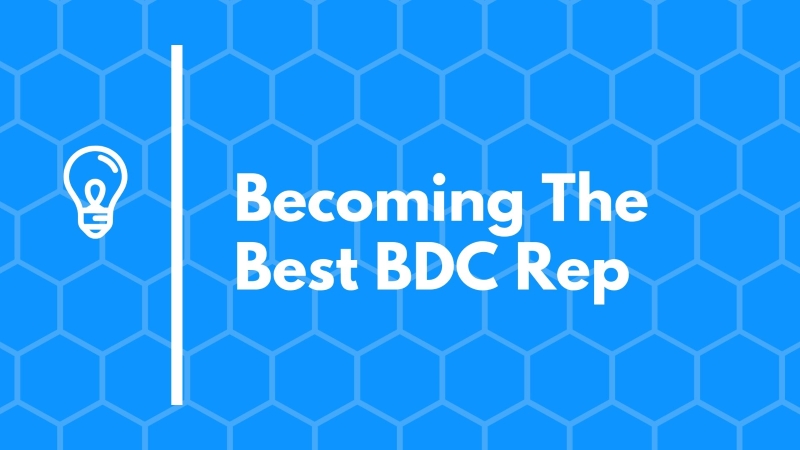
by Andrei Smith | Jul 19, 2019 | BDC Training, Mastering Sales
If you want to grow as a successful BDC representative, you need to be asking yourself the right questions. Even the top representatives have room to improve, and this article’s questions should unlock your potential!
If you’ve already read The Automotive BDC Manifesto, you are well on your way to being a top representative at your store. Choosing to follow a path of self-improvement is critical in every career path. Never forget the fundamental tenet of my book: BDC representatives are salespeople, not receptionists!
There is no guarantee that your managers or your coworkers will go out of your way to help you set more appointments. It’s time to take things into your own hands.
After you read this article, consider reading about my optimal BDC workflow.
Four Questions to Ask Yourself
Self-questioning is an essential part of improving your performance at work. You need to be able to ask yourself the hard questions, and be honest in your answers!
Successful BDC Representative Question #1: Do I Know My Product?
Salespeople need to be excellent at building relationships, over-delivering on value, and knowing their product. If you are expecting to be a top representative, convincing your clients to come in for appointments, you need to make sure you understand what you are selling.
Every manufacturer provides training for the sales representatives that work with customers on the floor. The manufacturer creates video training and will keep it updated with the new product launches.
Do you follow that training? Do you have a log in so that you can learn the answers to the questions that your customers are going to have?
Think about it this way: you are the front line dealing with the customers. We know that customers actively shop around at multiple dealerships. Do you think that we are putting our best foot forward by not knowing the answers to their questions?
If you don’t want to spend a few minutes a day watching the training videos, consider just walking the showroom with a salesperson, asking for information. Tell the sales representatives on the showroom floor that you will be better at setting appointments for them that sell if you have all the product information!
Small Steps to Product Mastery
I quoted my mentor Frank Garcia in The Automotive BDC Manifesto:
“I think it’s just little tweaks you need to put into action if you want to be more polished. It
will take a decision to start and a dedication to follow through. Polish is not about some
grand action; it’s a collection of little steps—little steps that you care about.”
Take the small steps every day to perfect your product knowledge.
Not only will you be more successful with the customers, but you will also be setting creating personal value that will protect during market downturns.
Things you can do to learn about the product every day include:
- Asking the managers about new products that have arrived
- Sitting in all the showroom cars for a few minutes every week to try out new features
- Asking for a demo car for a day (perhaps from loaner fleet?) to drive and get the feel of
- Read online publications that discuss the product, such as Car and Driver or Road and Track
These are the little steps that will push you to the next level.
With the knowledge from these small steps, you will be prepared; the customer asks you questions such as:
- Does all the Audi Q5’s come with parking sensors?
- When does the new Allroad come out?
- Is there any difference in the new Audi Q7 compared to last year?
When you can answer these questions with confidence, you prove your dealership’s value to the customer. Every time you say, “Uh… let me check” you are losing rapport.
Successful BDC Representative Question #2: Do I Know My Salespeople?
When working the automotive BDC, you are a piece of a much larger machine. There is a funnel of customers that flows through your desk that ends up sitting with the salespeople. Both your customers and your salespeople have peculiarities.
The oddities of your customers will be made clear quickly as you work in the BDC. Although most of your customers will love getting updated on the status of their incoming cars, some will yell at you merely for calling. Some customers will only text, refusing to ever jump on the phone. There will be customers that never respond to a single follow-up touch, but then come in and buy on a random weekday afternoon with no warning.
Your customers are going to fall on a spectrum, from gentle to mean, from wealthy to not.
Guess what?
Your salespeople do too!
Learning about your Partners
Your salespeople that you assign appointments for when working in the automotive BDC are your partners. Never forget how much you all rely on each other! Think of the problems that arise when communication and relationships are lacking:
- Salespeople can forget to log appointments, costing BDC reps money
- BDC reps can forget salespeople’s days off, costing salespeople half deals
- Salespeople can not update the notes in the CRM, causing more work for the BDC
- BDC reps can forget to update salespeople on their customer’s plans, costing the salespeople some of their rapport
It’s a transparent back-and-forth.
So, put some Mariah Carey on and get to learn about each other! This is your responsibility if you want to be a successful BDC representative!
Here are some ways that you can get to know the sales staff better:
- Attend the weekly sales meetings
- Ask the salespeople what the BDC is doing well and what it could do better
- Ask the salespeople if there are any problems that they’ve noticed that they haven’t addressed
- Ask the sales manager to host team night for everyone to meet up outside of work
When the BDC and the sales floor work with each other, the result will be more successful appointments, better CRM usage, and more sales.
It’s worth it! Get to know your extended team!
Successful BDC Representative Question #3: What Percentage Do I Close?
Do you know the answer to this question:
What percentage of inbound leads do you set appointments for? What percentage of those appointments sell?
If you don’t know the answer to this question, then how will ever know if your performance improves?
Careful tracking of Key Performance Indicators (KPI) is the only way to track your relative performance at work.
Why do I say that?
Think about it this way. If you set 50 appointments every month for three months, and then you set 30 appointments in the fourth month, were you less effective in the fourth month? The fact is, unless we know the amount of opportunity you had in the fourth month compared to the previous months, we can’t identify your actual performance.
What if in the first three months you had 100 opportunities and in the fourth month you only had 60? In that case, your relative effectiveness went up in the fourth month, from 30% appointment setting to 50%!
Example KPI for Successful BDC Representatives
Here is a list of the fundamental Key Performance Indicators that I recommend you track as a BDC representative:
- The ratio of Appointments Set (Appointments Set divided by Number of Leads)
- The ratio of Appointments Shown (Appointments Shown Divided by Number of Appointments Set)
- The ratio of Appointments Sold (Appointments Sold divided by Number of Appointments)
- Sales Person Effectiveness Ratio (Appointments Sold divided by Appointments Shown)
With these four metrics, you can have a gauge of your relative effectiveness. If you wish to improve, track these four ratios!
In The Automotive BDC Manifesto, Anthony Rinaldi shared with us (in his bonus chapter) his ratios of success that he looks for:
Outbound: For every 80 outbound phone calls, expect 20 conversations, which leads to 10
appointments, of which 5 will show, and 2 will buy.
Inbound: For every 100 inbound phone calls, expect 50 appointments, 25 shows, and 12 sales.
If your numbers are vastly different from these ratios, shoot me an email, and we can delve into what is going on!
Successful BDC Representative Question #3: Do I Know My Market?
In How to Sell Cars on the Internet, I delve into the importance of market research:
When you are selling cars on the internet, you need to know your market.
Your market is defined by the group of surrounding dealerships. In a thriving market, there will be plenty of
sellers and plenty of buyers. Dealers can differentiate themselves in three arenas: pricing,
customer service, and inventory.
Pricing includes the price you sell your cars for and the financing you offer. The pricing
you should provide (to be competitive) will be investigated in this chapter.
Customer service is a broader category, including timeliness, transparency, unique perks
(such as free servicing or details), pick up/drop off services, and general demeanor when
working with the customer.
Inventory, the final differentiator, is about volume. When a customer goes on your
website or visits your dealer, they want to have options on colors and features. The more cars
you have, the more options they have.
I know a significant number of BDC reps are asking themselves the same question right now:
“Wait… isn’t this the responsibility of my managers?”
If you think that market research “isn’t your job,” you are technically correct. That said, technically, most representatives never move up to manage an entire BDC. Most representatives act like Ziggy instead of Zag.
Your desire to succeed can be held back by your belief in the limitations of your role at the dealership. If you are willing to take on additional challenges, such as market research, you will stand out and make a name for yourself.
Review
This article should be one step in your path to becoming a top tier automotive BDC representative. If you have questions, shoot me a message here. If you want to join the community, check out our Facebook group, Ethical Internet Managers, Sales Managers, and BDC.

by Andrei Smith | Jul 8, 2019 | Mastering Sales
Superstar car salespeople and BDC representatives need to master auto sales skills to get ahead. One of the essential auto sales skills is the ability to do trial closes and then ask for the business confidently.
Imagine a world in which you were the only person with a unique superpower: You could read people’s thoughts, just by looking at them.
You would go to work every day and handle every auto sales negotiation correctly, always staying one step ahead of your customers.
When they bluff, you’d know. When they lie about how much discount they need to make a deal, you’d know. When they say they won’t pay a penny over invoice when they really would, you’d know.
What a successful salesperson you would be.
Guess what? You don’t have that superpower.
You are blind to what customers are thinking. You may pick up a subtle physical cue here or there, but overall, the customer’s mind is a black box.
Auto Sales Skills: How to Take Off the Blindfold
During your negotiations, you should be following a relatively simple template. Get the customer on a specific car, figure out how they want to buy the car (cash, lease, or finance), and then offer terms. These are the necessary auto sales skills.
When it comes to reviewing terms, you will often face a dilemma. How should you structure a deal?
How aggressive do you need to be in terms to make a deal?
Do you offer an aggressive number right off the bat? Or do you provide the standard price and see what they say?
You can’t know what is in a customer’s brain.
That is, you can’t know what is in a customer’s brain UNTIL YOU ASK!
How the BDC Can Ask Confidently (and Nicely)
Car sales skills come in all shapes and sizes. The ability to ask for money in a friendly, confident way is one of the vital differentiators between those who make an average income and those who make the top 5% of profits.
This applies to more than just money. In the BDC (Business Development Center), representatives need to ask for an appointment almost every time they are on the phone with a customer.
A top tier BDC representative will ask for the appointment at every opportunity (within reason). Every phone call by a BDC representative is an opportunity to provide a reason to come in. Perhaps the exact car they want is in stock, or there is a special sale running that includes the model they want.
Asking with confidence is vital. You need to believe in what you are offering in exchange. Does your tone of voice convey the reason for your call?
The benefit of the BDC is that your leads have often self-qualified. They will put in a lead describing what they are looking for.
Here is an example of confidently asking for an appointment, using the information provided by the customer:
“Thanks for jumping on the phone with me Tim. Last time we spoke you had mentioned that you were on the hunt for a 2020 Jeep Wrangler in the Steel Gray and Fire Red interior. I’ve just been notified that we recieved a car just like that today. I have some time available at 5:45pm today for you to come by, would that work for you?”
The BDC representative knows what the customer wants, so they can confidently ask for an appointment. There is value being offered by the representative.
The BDC is protected by the telephone. There is always an immediate opt-out available for the customer, as they can hang up. The BDC manager can monitor the word tracks of the representatives to make sure they are setting good appointments.
The salesperson that is face to face with a customer faces a different situation.
The Trial Close
When a salesperson is in front of a customer, they should be utilizing the trial close. Since it is so common to be working with a customer for the first time, you need a way to know if what you are showing the customer resonates with them.
Many salespeople ask for the business too early in the conversation because they forget to use trial closes.
The trial close is when the salesperson asks questions about how the customer feels about the sales process so far without directly asking for the business.
Trial Close:
“How do you feel about the lease special we have here on the windshield?”
Asking for the Business:
“If I was able to get you approved for this lease special, would you be ready to move forward today?”
The trial close is less direct than asking for the business. When you do constant trial closes throughout the process of showing a customer the car, you are getting a sense of the customer’s likelihood to buy without being overly pushy. You are “taking their temperature” instead of berating them.
If you have been taught to ask for the business consistently, I recommend you take a step back and think about the position you are putting the customer in. If you were at any store and the sales representatives kept asking if you were ready to buy, you would feel pressured. Don’t make that mistake with your customer.
Salespeople need to overcome the objections of their customers continually. The trial close will give you the information that you need to overcome objections in the first place!
When you do a trial close, the customer has an opportunity to “course correct.” They can tell you if the car you are showing them is outside their budget or in the wrong color, without feeling like they are being trapped into buying.
Auto Sales Skills: Did You Do Everything You Could Have?
So far, in this article, we have stressed the importance of confidently asking for business and consistent trial closes. How do you bring this all together when working with your customers?
In my experience, salespeople are much more likely to be afraid of asking for the business than asking too much. The salespeople that I know that are not performing up to their potential often are fearful of asking for the business because they don’t want to be rude. They know that selling cars is a great business, but they can’t figure out why they aren’t making more money.
To get a feel for where you fit into this, how often do you think:
“I want their phone number but it would be rude to ask for it this early in the process“
“I’d love to sell them a car but I don’t think they are ready. It would be better to avoid talking terms and just give them the best experience. I bet they will come back because of my customer service”
“Customers like me but they don’t buy from me! What’s going on?”
If you have been thinking about these three things, there is a high likelihood that you are:
- Not doing consistent trial closes
- Not asking for the business
The Magical Mindset
If you can consistently do trial closes and politely (but confidently) ask for the business, you are doing what is required of a top tier salesperson.
To unlock the confidence to do these two things, you need to use this magical mindset:
If I provide top tier service, consistently take my customers “temperature” with trial closes, and confidently ask for the business, then I have done a good job (regardless of whether they end up buying)
The key is to realize that the outcome (purchasing or not purchasing a car) is not 100% within your control. It is your responsibility to ask from the customer, but not every customer will buy every time.
Auto Sales Skills: Look at Your Ratios
I would guess that most salespeople reading this article don’t know their exact closing percentage. The fact is, most salespeople still do not adequately use their CRM, so they can only guess what percentage of customers they close. What is the point of working on your auto sales skills if you don’t know how you are doing right now?
Here is the fact of the matter: if you don’t know your closing percentage, you don’t know if you are good at your job.
There are excellent 10-car salespeople, and there are terrible 30-car salespeople. The exact volume of cars they sell has nothing to do with it. The thing that proves a good salesperson is their ability to convert the opportunities they have.
If the theoretical 30-car salesperson had 500 customers and only sold 30 cars, they are lackluster. If the 10-car salesperson had 30 customers, they are doing very well.
Review: Auto Sales Skills
We can all work to improve our presence in front of the customer. Always put yourself in their shoes. How would you like to be treated when you are in the market?
This week, practice utilizing trial closes with your customers. Throughout your sales process, ask the customer how they feel about what you are presenting. Are they getting more excited? Are you showing things that resonate with them?
If you have additional questions, feel free to contact me directly.
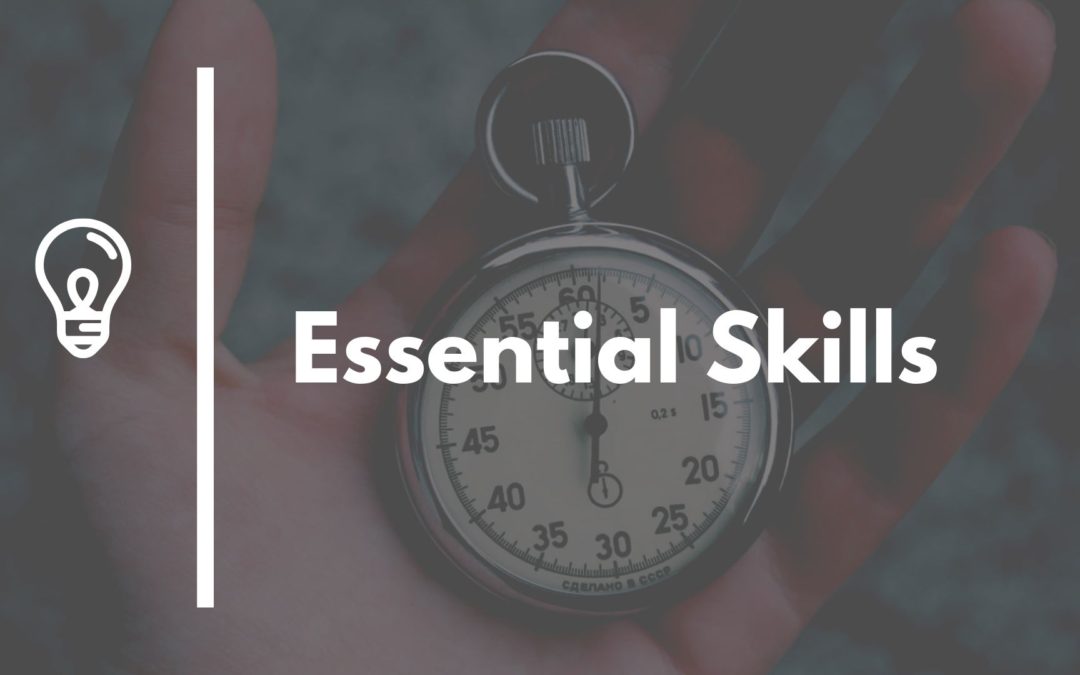
by Andrei Smith | Jun 27, 2019 | Mastering Sales
This article “Car Sales Skills” is a timely article. As I am writing this, the fiscal quarter is ending for my dealership, and we are wrapping up the last few deals of the month. After traveling for a few weeks, I ended up back at my desk with a large quota to conquer and a week to do it. Every day I’ve been bringing my best face forward to work with the customers, and I’ve been paying attention to what works best when I’m in the zone.
It’s from these customer experiences that I distilled down these three car sales skills. The three car sales skills that I’ve focused on are patience, determination, and organization. I’ll break down how I think these three car sales skills can help you set yourself up for success when working with customers.
Patient Mindset: How Long Can You Take It?
I’ve spoken about patience before, in my 2018 wrap-up article:
Blogging, as my side business, is slow going. It’s a labor of love, one that takes a long time to scale to reasonable profitability. Anyone that sells you the “overnight success” story is just making shit up- I can tell you that honestly from the trenches. I figured that if you break down my hourly rate on this project, I would be making an average of a dollar an hour.
So why do it? The easy answer is- I’m just not there yet. One day I will make more. Matthew McConaughey, that weird actor dude, once said that “my hero is myself, in ten years.” Although that still sounds a bit odd, I like the sentiment. Right now I make $1/hour doing this blogging business, but six months ago I was losing money doing this. Now I have passed breaking even; I only have one way to go (up, hopefully)!
So patience is key. In blogging, in automotive, and life. It took me a while to figure that out.
This above advice that has only become more relevant to me.
Car Sales Skills: Becoming a Patient Chameleon
You can’t just sell easy car deals. To sell the volume that it takes to set yourself up for financial independence, you need to sell the vast majority of types of people cars. That means you need to sell slow customers, the fast customers, the cheap customers, and the barely-speaking-English customers. To make the outsized incomes that car salespeople routinely make, you need to master the art of the patient chameleon.

The patient chameleon can take 10x the punishment of the average salesperson, changing attitude to facilitate the demanding customers. Why is it important to remind yourself to be patient? The reason is simple; it’s easy to get burned out when working directly with the public. You are liable to have to answer the same questions, day in and day out, to customers that are often thankless. That can grate on anyone, especially when you’ve been working at a store for more than a few years.
When you are a patient chameleon, you know going to work that customers are going to grate on you. You see it coming, and you plan for it. The patient chameleon shifts their attitude to facilitate the customers.
I make a game out of being patient. When confronted with a demanding customer, I mentally go through a few steps:
- I remind myself that if I get upset, this will only get more difficult
- I think of all of the times that I have dealt with demanding customers successfully in the past
- I challenge myself to give this customer a perfect experience, regardless of how difficult they are
Rather than treating the customer as the challenge, I create a game out of being perfect. The more complicated the customer, the more difficult the game, the more accomplished I am if I succeed.
The Patient Chameleon Saves It’s “No’s”
Customers can only be told “No” a certain number of times. The majority of customers can only be told “No” three or four times before turning against you. Once you have exhausted that number, the customer will resent you, deeming you unworthy of their business.
When you consistently oblige a customer wishes for the majority of the sales process, you are saving your “No’s” for later. That way you can say “No” a few times during the negotiation and still maintain the customer satisfaction you need!
Even the Patient Chameleon has Limits
Ok, so that sounds great, but how realistic is it? I’d say harnessing the “patient chameleon” mindset and running with it will work with 80% of the demanding customers. That said, once in a while, you will run into one of those world-ending customers. The customers that don’t trust you fight you every time and refuse to be happy.
These are customers that I politely let go. It’s not worth it for me to try and fix a broken person. Perhaps they are inherently bad or possibly it’s just not their week, but regardless, I don’t need to ruin my week helping them.
When I deal with a customer like this, I will give still give it a good attempt. I will bend over backward, but only to a point. When they begin to become distinctly unpleasant, I find a way to let them go. Until you’ve worked in customer service for a few months, you might not know what I mean, but you will know when you see it.
So how do you get rid of a customer like this? If they are looking at cars, I would test drive and show them the vehicles they are interested in, and then let the conversation reach a natural end. I might mention an upcoming appointment and suggest that we schedule a follow-up. In the worst cases, I have told the customers that I think that “this isn’t working for us,” and I offer to direct them towards some other store that might be able to help them.
Determined Mindset: How Long Can You Last?
I’ve had one big goal since I graduated from university: Financial Independence. The idea of having enough capital investment to buy my freedom from work has been the central tenet of my working career for seven years now. Perhaps it’s my dislike of being managed or my hatred of going to the same building every day. Whatever it is, I’ve wanted to become financially independent since the second week I began working. I’ve worked every day with that goal in mind, determined to make it my reality.

You need to be able to put off what you want now in the short term for your “big goal” in the future.
Your goal may be different. Perhaps you dream of owning a home or putting your kids through the best Universities without debt. Regardless of what your goal is, you need to have a “finisher’s” mindset. That means that you are singularly dedicated to accomplishing the goal that you set for yourself. You have told yourself that you will do what it takes to get to where you want to go.
My goal of Financial Independence requires me to save over a million dollars and have it invested. The magic of compound interest means that the earlier I begin investing, the better I will do.
Car Sales Skills: Dedication to a Big Goal
When working with customers, you need to remember the “big goal” that you align your work life with. When you consider the house that you and your spouse want to put a down payment down on, you get a bird’s eye view of your job. It is a means to an end. As such, there isn’t an option for you to “give up” on a deal. You can’t “half-ass” it. The only option for you, if you hope to accomplish your goals, is to work hard and work efficiently.
This determination to accomplish your goal will give you the ability to accept new challenges at work. You will be willing to take on projects that seem outside of your skill set, with the understanding that you will learn what you need to accomplish the small tasks.
Every customer is both a person who needs care and attention and a brick in the road to your “big goal.” Never forget this balance.
Organized Mindset: Can You Juggle?
If you plan to build a road, brick by brick, to reach your “big goal,” you need to stay in a straight line. Being organized is so often ignored, even though it is a requirement for operating at your highest capacity. You need to be able to juggle your responsibilities at the dealership and never drop the ball.

In the car dealership, having an organized work life means that you have a firm grip on what you are working on every hour of the day. Your desk is clear of clutter, and your email inbox is under control.
Personal organization is the shield that stands between you and potentially letting down customers. How often do you forget about an appointment or an email because you were scatterbrained? Do you ever forget about responding to a text because it sinks into your messy message inbox?
I use a few key strategies to keep myself together.
Car Sales Skills: Organization Tools
My first tool to keep myself organized is my paper hot customer list. I always have a piece of blank printer paper followed to 1/3 size with a list of my hottest customers. I jot down their names and the car they are interested in, plus the date of their next appointment. If they don’t have an appointment, it sits blank, driving me to follow up with them.
I’ve tried using excel, my CRM, outlook, and an array of other tools, but for this, nothing beats paper. That little paper reminder of my highest potential customers keeps my head in the game every day.
My second tool to keep myself organized is my CRM strategy. By focusing on “Update Days” in Dealersocket, I can always make sure that my web leads are followed up with on a regular schedule. The “update days” metric is the linchpin of an effective follow-up strategy. If your customers are being touched every three days, they are unlikely to be forgotten.
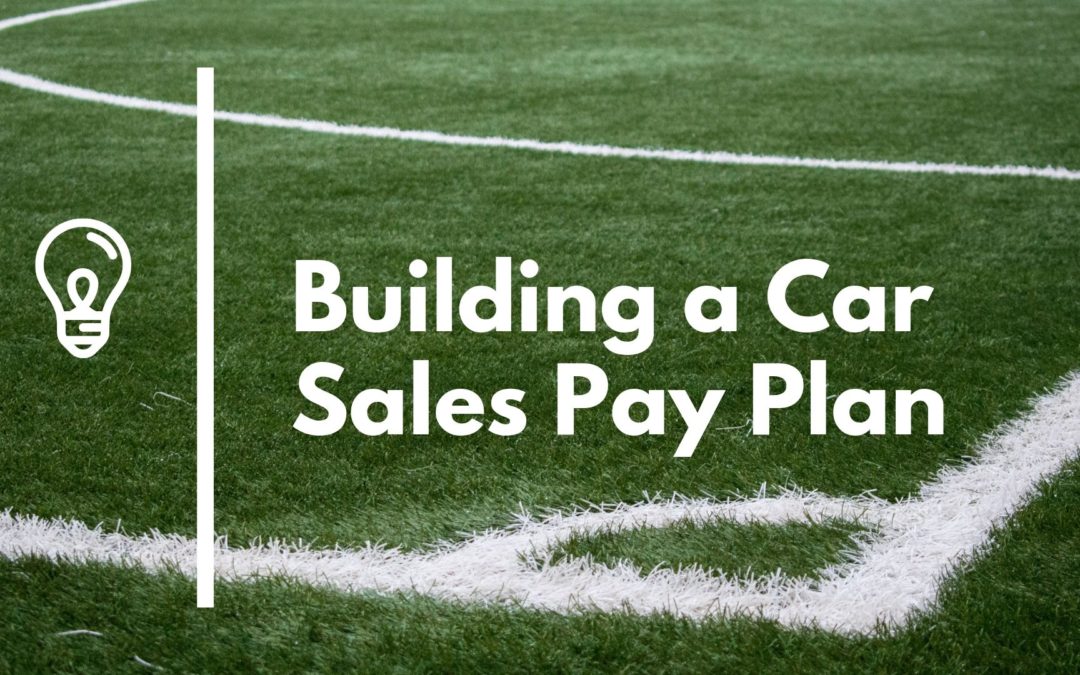
by Andrei Smith | Jun 24, 2019 | Mastering Management, Mastering Sales
What is the ideal car salesman pay plan?
The pay plan is the most important guiding document of a sales organization. How you pay your salespeople dictates how they will act. If you focus the pay plan around profit, your salespeople will focus on profit. If you concentrate the pay plan on volume, they will focus on selling as many units as possible.
There is no one “perfect” car salesman pay plan. That said, there are some guiding principles that all car salesman pay plans should adhere to (and some potholes to avoid).
In today’s article, I’ll be reviewing the various facets of the car salesman pay plan, with a focus on best practices. Make sure that you always keep in mind what your salespeople think about their commission.
Crafting the Perfect Car Salesman Pay Plan: Figuring out a Target
Just like any real estate deal or business plan, the perfect car salesman pay plan starts by working the numbers backward. You need to build a car salesman pay plan that enables your top performers to make more money than they could anywhere else, while also allowing your average salespeople to make an area-adjusted average income.
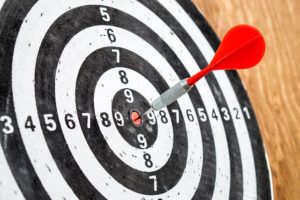
Your car salespeople sacrifice to work their job. Those with the skills you seek are valuable assets to your company that need to be compensated accordingly. Your top performers could sell at any dealership, and often, in other industries as well. Your salespeople are probably working long hours and weekends away from their families, in a position with plenty of stress.
In the San Francisco Bay Area, the competition that you face as an employer is mostly from technology companies. These technology companies often have better working conditions and hours than your dealership. To capture your salespeople, you need to enable them to make more money at your dealership than they could if they switched over to technology sales (at least for the first few years). Making a strong income quickly is one of the biggest draws of the car sales career.
Market Research (Other Business Types)
As a sales manager, the first thing you should do when researching your car salespeople’s new potential pay plan should be to find out the optimal income level that you want the top 20% to be able to achieve.
The optimal income level comes down to what is available in your local market for your employees. To figure this out, I recommend speaking to real people rather than relying on aggregator websites such as Glassdoor.
In my area, new salespeople at the dealership could qualify for entry-level “Sales Development Representative” roles at local technology companies. These roles pay between $55k to $75k after bonus in my area, with full health care benefits and beautiful offices. I can find this out quickly by reaching out to a few of my long term customers and friends that work in those businesses.
Therefore, to attract talent to work at the car dealership, I need to have my top 20% of staff be able to make between $80k and $90k in their first year. This extra money will ensure that the salespeople will have to take a pay cut to change industries. This number ($80k, for example) will be what I use to work backward from to build a pay plan.
Market Research (Other Dealerships)
Many car dealerships in my area are plagued with expensive turn-over rates. Therefore I don’t rely on comparisons to their pay plans since what they are doing isn’t working.

That said, if there is a superstar dealership in your area, I always recommend figuring out what they offer. The experience of your salespeople is more than pay, but it is a critical piece of the puzzle.
Crafting the Perfect Car Salesman Pay Plan: Working Backwards
Now that we have our “goal” income ($80k), we can begin to work backward to design the car salesman pay plan.
Our perfect car salesman pay will be competitive enough to keep our employees happy while aligning their activities with our business goals.
Let’s start with some example business goals:
- Max Volume: You want your dealership to sell as many cars as possible. Gross profit is less important. This strategy is generally based around having a profitable service center and an aggressive manufacturer stair-step program.
- Max Profit: You want your dealership to make money where it can, and as much as possible. Gross profit per car is incredibly important to your dealer. This strategy is generally based around having less service retention and a smaller volume of vehicles on the lot.
- Mixed: You want units, you want gross profit, you want it all. You need to have balance.
Max Volume Dealership Example
Let’s say you work at a dealership that is focused on maximizing the volume of cars sold. You have plenty of inventory in stock, and you need to move it.
When building a car salesman pay plan for a dealership like this, you are going to put the focus on unit bonuses. You don’t want your salespeople to stress on the front end profit of deals. You want your salespeople to bring you every transaction, regardless of the offer.
Let’s work backward. Our top-20% salesperson needs to make $80k/year for our store to be competitive. Therefore, they need to make $6600/m when performing at their level. At the current time, this type of salesperson sells 12 cars per month. In California, I need to pay $1000/m as basic income, so I need to spread $5600 over those 12 cars. A simple way to build this pay plan would be to structure it as such:
If you sell 1-11 vehicles, you make $400/car (plus $1000 base pay)
If you sell 12+ vehicles, you earn $475/car (plus $1000 base pay)
Now my salespeople that sell ten cars a month will make $5000 per month and my salespeople that sell 12 vehicles per month (the top-20% salespeople) will earn $6500. This significant jump between 10 and 12 cars should encourage salespeople to push to at least sell 12 cars.
Max Profit Dealership Example
Let’s take the exact opposite strategy, max profit. The logic is simple with this strategy. You need to align your salespeople with making as much profit as possible. The easiest way to do this is to focus their pay plan around a high percentage of profit offered.
After discounts in your market, your average front end profit is $900 per car. Your goal with this strategy will be to beat this number. A reasonable goal might be $1100 profit per car. If your average salesperson sells 12 cars a month here is the math:
$1100 goal profit per car * 12 cars sold on average = $13,200 profit
You will need to give your salespeople a reasonable minimum commission per car to keep morale high, so let’s say you pay a $300 mini per car sold:
$300 minimum commission * 12 cars sold on average: $3,600 income on 12 cars sold minimum
With a $300 minimum commission, your 12 car salesperson is making $3,600. You need to get that number to $6600 per month based around a target profit of $1100 per car. Out of the $13,200 profit, you need to pay $3000.
$3000 additional commission needed / $13,200 profit goal = .22 -> 22%
Done, here is our pay plan. We pay $1000 for showing up and $300 mini per car sold. On top of the mini, we pay the salesperson 22% of the gross front end profit:
$1000 Minimum
$300 Mini Per Car * 12 Cars = $3600
Plus 22% of $13,200= ~$3000
Total Income: $6600 per month
The Reality of The Situation
The reality of the situation is this: you already have a car salesman pay plan in place at your dealership that your salespeople are used to. All salespeople fear their pay plan changing, which means that you will likely not be able to institute a completely new pay plan without considerable upset.
The purpose of this article is to give you instead of an idea of how you might go about tweaking your store’s current pay plan to align better with your goals.














